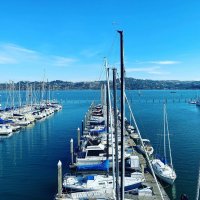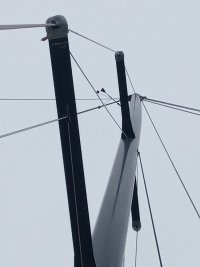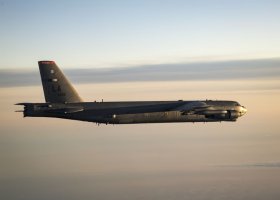You are using an out of date browser. It may not display this or other websites correctly.
You should upgrade or use an alternative browser.
You should upgrade or use an alternative browser.
Mast bend
- Thread starter Kenneth K
- Start date
Rocinante33
Contributing Partner
Ken,
It doesn’t seem too much but I’m used to looking up at my fractional rig which has quite a bit more bend and rake, both. Bend is probably only inches over the whole length of the mast.
You could measure it, then maybe someone could comment constructively. Hang a halyard with a small weight attached hung down to deck level. How many inches out from the mast is the hanging halyard, a) at deck level and b) up as far as you can reach to measure? Mid mast would be best for this measurement, I think.
As far as wrinkles, those are probably artifacts from manufacture and not induced by bend. Many Ericsons are Kenyon masts which are stout.
How is the helm under sail when close hauled? A little weather helm is good. This is affected by mast rake, afaik.
It doesn’t seem too much but I’m used to looking up at my fractional rig which has quite a bit more bend and rake, both. Bend is probably only inches over the whole length of the mast.
You could measure it, then maybe someone could comment constructively. Hang a halyard with a small weight attached hung down to deck level. How many inches out from the mast is the hanging halyard, a) at deck level and b) up as far as you can reach to measure? Mid mast would be best for this measurement, I think.
As far as wrinkles, those are probably artifacts from manufacture and not induced by bend. Many Ericsons are Kenyon masts which are stout.
How is the helm under sail when close hauled? A little weather helm is good. This is affected by mast rake, afaik.
David Grimm
E38-200
Kennith, I just stumbled upon this series of sail trim videos from North Sails. Seems one of the first steps for trimming the sails is adjusting the backstay. I have never touched mine in 3 years of ownership. Also there is a great little app (north u) on google play store that lets you practic sail setup on a neat little simulator.
Thanks for the comments. There is definitely a slight back bend to the mast and a hanging halyard does seem to lie mostly 4-5 inches behind the mast.
I do have a slight weather helm when close hauled but never have thought it was excessive. Probably more than anything else, it’s just those visible wrinkles that keep me wondering. And yes, it’s a tapered Kenyon spar.
I do have a slight weather helm when close hauled but never have thought it was excessive. Probably more than anything else, it’s just those visible wrinkles that keep me wondering. And yes, it’s a tapered Kenyon spar.
Last edited:
David Grimm
E38-200
In the video series they mention moving the traveler to windward to reduce weather helm. Have you ever thought of a backstay adjuster? I've seen Ericsons with them. I have also read that most cruisers don't bother with them.
When you do replace the standing rig, add a self-contained hydraulic BS adjuster and also a new turnbuckle. That's what we did a long time ago. That way if, for any reason, the hydraulic one leaks out or somehow looses function while you are cruising hundreds of miles from home, you can always take up on the turnbuckle and have basic tension again. That's a hint from a rigger that I have known for years.I’m definitely a cruiser, and a pretty casual one at that. I don’t think a backstay adjuster would be on my list for quite a while. I’d be much more inclined to replace all the existing standing rigging first.
Added to the list.....When you do replace the standing rig, add a self-contained hydraulic BS adjuster and also a new turnbuckle.
Frank Langer
1984 Ericson 30+, Nanaimo, BC
Hi,
Don't underestimate the value of a backstay adjuster, either manual or hydraulic, in flattening the mainsail, reducing heel and making the boat more manageable in stronger winds. A combination of boom vang, outhaul and backstay adjuster makes a big difference when cruising in a stiff breeze.
Frank
Don't underestimate the value of a backstay adjuster, either manual or hydraulic, in flattening the mainsail, reducing heel and making the boat more manageable in stronger winds. A combination of boom vang, outhaul and backstay adjuster makes a big difference when cruising in a stiff breeze.
Frank
David Grimm
E38-200
Kenneth, Now you have me thinking about the rigging I stumbled across this video. This tension measurement tool can be found on amazon for 110 to 260 bucks. It Would complement the other tools on the boat nicely!
Agreed - I have the same mast. It's made tapered in the top section, not bent back. Nothing to see here ... move along ;-)I think our rigs are tapered which would give the appearance of bend when you look at the front. Does it still look like there's a curve when you look at the back of the mast?
That the whole mast is angled aft a bit (rake) is normal - helps overcome weather helm. I think our main halyard should hang and touch the boom about 4-6" aft of the mast track (when the boat's floating level fore and aft).
It's uncanny, but whichever model of the Loos gauge you get, the wire size range that it covers is one wire short of the whole set you need. For my Beneteau 235, the LP-1 did all stays except one stay. I had to get the PT-2 for that biggest stay. I sold the PT-1 to a friend when I got my E32-3, but now the LP-2 doesn't go up to the size of the forestay. But, as it's a masthead rig, I think I can get the forestay right if I get the backstay right. BTW, I see that Spinlock makes nice-looking gauges too.Kenneth, Now you have me thinking about the rigging I stumbled across this video. This tension measurement tool can be found on amazon for 110 to 260 bucks. It Would complement the other tools on the boat nicely!
When you measure the tension of the backstay, you also should have the same amount of force on the opposite... forestay. Good thing, since most of us have the forestay covered by a furler.
I don't understand mast bend in a masthead sloop with in-line spreaders and no baby stay. On a fractional rig it makes perfect sense, but on a masthead rig it just seems to be compressing the mast to the point of buckling. What's keeping the mast from bending in the wrong direction? It seems more likely that a backstay tensioner on a masthead rig just tensions the forestay. On our keel stepped rigs, is the mast partners providing the necessary 3rd point to induce bend (in the correct direction)?
IMHO, you are mostly right... but after using the BS to tension up the forestay, we can also bend our spar about 4 to 6 inches. If... our main were cut specifically for this, it would help to flatten the main. We have never tightened it sufficient to really do that. Partly because we do not need the extra nano-knot as we would if racing, and partly because it seems like extra stress on the boat for minimal return.I don't understand mast bend in a masthead sloop with in-line spreaders and no baby stay. On a fractional rig it makes perfect sense, but on a masthead rig it just seems to be compressing the mast to the point of buckling. What's keeping the mast from bending in the wrong direction? It seems more likely that a backstay tensioner on a masthead rig just tensions the forestay. On our keel stepped rigs, is the mast partners providing the necessary 3rd point to induce bend (in the correct direction)?
(OTOH, our previous boat was a fractional rig, and we could regularly bend the mast quite a bit to change the shape of that large mainsail.)
Note B: with double lowers, on your rig, I believe that you would need to change the tension on the aft lowers a bit to allow a uniform curve in the mast if dialing in some curve. We have single lowers, so this is not a concern, and our rig does have check stays to stop it from pumping when in bigger waves.
Last edited:
I came to this same conclusion after thinking this through several times. With a masthead rig, in order to bow or flex the mast, one has to be compress the spar hard enough to distort the aluminum extrusion. That's an (ahem) boatload of force. Is the mast designed for that? Probably. Is the 30-40 year old TAFG/Hull combo? (And how would one find out if the answer was no?)I don't understand mast bend in a masthead sloop with in-line spreaders and no baby stay. On a fractional rig it makes perfect sense, but on a masthead rig it just seems to be compressing the mast to the point of buckling. What's keeping the mast from bending in the wrong direction? It seems more likely that a backstay tensioner on a masthead rig just tensions the forestay. On our keel stepped rigs, is the mast partners providing the necessary 3rd point to induce bend (in the correct direction)?
This video has an explanation that helped clarify it for me:
Also, from a recent trip up my mast, one can see the white spar fractional rig (three masts down) substantially bowed. The boat with the black mast in the immediate foreground is an E30+ (also a fractional rig) with little to no bow.

Incidentally, if anyone wants an inexpensive 30+ in Sausalito, the backstory on that boat in the foreground is that it never moves, and that is in part because the inexperienced owner had the boat out and the engine on with the impeller through-hull closed and overheated the engine. He wants to get rid of it, but it has, you know, "issues" now.


